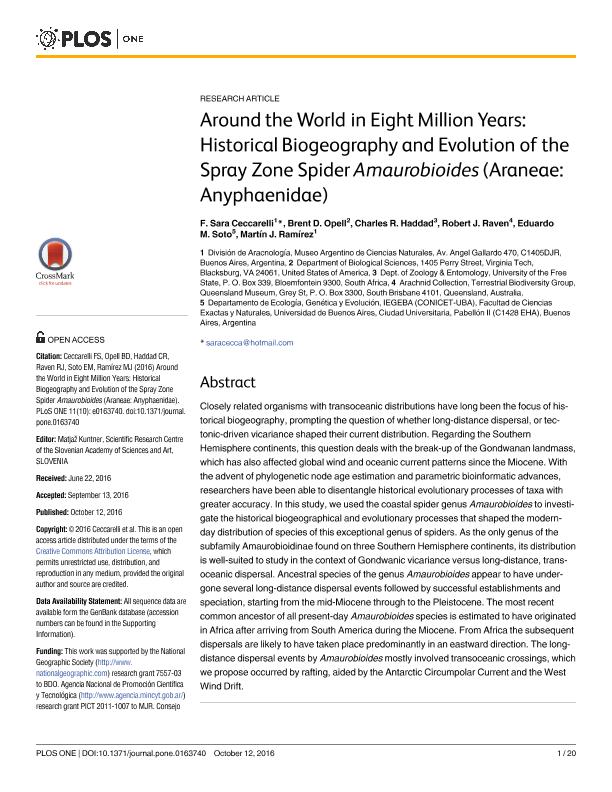Mostrar el registro sencillo del ítem
dc.contributor.author
Ceccarelli, Fadia Sara

dc.contributor.author
Opell, Brent D.
dc.contributor.author
Haddad, Charles R.
dc.contributor.author
Raven, Robert J.
dc.contributor.author
Soto, Eduardo Maria

dc.contributor.author
Ramirez, Martin Javier

dc.date.available
2018-09-14T20:49:36Z
dc.date.issued
2016-10
dc.identifier.citation
Ceccarelli, Fadia Sara; Opell, Brent D.; Haddad, Charles R.; Raven, Robert J.; Soto, Eduardo Maria; et al.; Around the world in eight million years: Historical biogeography and evolution of the spray zone spider Amaurobioides (Araneae: Anyphaenidae); Public Library of Science; Plos One; 11; 10; 10-2016; 1-20; e0163740
dc.identifier.issn
1932-6203
dc.identifier.uri
http://hdl.handle.net/11336/59800
dc.description.abstract
Closely related organisms with transoceanic distributions have long been the focus of historical biogeography, prompting the question of whether long-distance dispersal, or tectonic-driven vicariance shaped their current distribution. Regarding the Southern Hemisphere continents, this question deals with the break-up of the Gondwanan landmass, which has also affected global wind and oceanic current patterns since the Miocene. With the advent of phylogenetic node age estimation and parametric bioinformatic advances, researchers have been able to disentangle historical evolutionary processes of taxa with greater accuracy. In this study, we used the coastal spider genus Amaurobioides to investigate the historical biogeographical and evolutionary processes that shaped the modern-day distribution of species of this exceptional genus of spiders. As the only genus of the subfamily Amaurobioidinae found on three Southern Hemisphere continents, its distribution is well-suited to study in the context of Gondwanic vicariance versus long-distance, transoceanic dispersal. Ancestral species of the genus Amaurobioides appear to have undergone several long-distance dispersal events followed by successful establishments and speciation, starting from the mid-Miocene through to the Pleistocene. The most recent common ancestor of all present-day Amaurobioides species is estimated to have originated in Africa after arriving from South America during the Miocene. From Africa the subsequent dispersals are likely to have taken place predominantly in an eastward direction. The long-distance dispersal events by Amaurobioides mostly involved transoceanic crossings, which we propose occurred by rafting, aided by the Antarctic Circumpolar Current and the West Wind Drift.
dc.format
application/pdf
dc.language.iso
eng
dc.publisher
Public Library of Science

dc.rights
info:eu-repo/semantics/openAccess
dc.rights.uri
https://creativecommons.org/licenses/by-nc-sa/2.5/ar/
dc.subject
Antarctic Circumpolar Current
dc.subject
Long-Distance Dispersal
dc.subject
Oceanic Drift
dc.subject
Rafting
dc.subject
Southern Hemisphere
dc.subject
Transoceanic Dispersal
dc.subject
West Wind Drift
dc.subject.classification
Otras Ciencias Biológicas

dc.subject.classification
Ciencias Biológicas

dc.subject.classification
CIENCIAS NATURALES Y EXACTAS

dc.title
Around the world in eight million years: Historical biogeography and evolution of the spray zone spider Amaurobioides (Araneae: Anyphaenidae)
dc.type
info:eu-repo/semantics/article
dc.type
info:ar-repo/semantics/artículo
dc.type
info:eu-repo/semantics/publishedVersion
dc.date.updated
2018-09-14T13:15:30Z
dc.journal.volume
11
dc.journal.number
10
dc.journal.pagination
1-20; e0163740
dc.journal.pais
Estados Unidos

dc.journal.ciudad
San Francisco
dc.description.fil
Fil: Ceccarelli, Fadia Sara. Consejo Nacional de Investigaciones Científicas y Técnicas. Oficina de Coordinación Administrativa Parque Centenario. Museo Argentino de Ciencias Naturales “Bernardino Rivadavia”; Argentina
dc.description.fil
Fil: Opell, Brent D.. Virginia Tech University; Estados Unidos
dc.description.fil
Fil: Haddad, Charles R.. University of the Free State; Sudáfrica
dc.description.fil
Fil: Raven, Robert J.. Queensland Museum; Australia
dc.description.fil
Fil: Soto, Eduardo Maria. Consejo Nacional de Investigaciones Científicas y Técnicas. Oficina de Coordinación Administrativa Ciudad Universitaria. Instituto de Ecología, Genética y Evolución de Buenos Aires. Universidad de Buenos Aires. Facultad de Ciencias Exactas y Naturales. Instituto de Ecología, Genética y Evolución de Buenos Aires; Argentina
dc.description.fil
Fil: Ramirez, Martin Javier. Consejo Nacional de Investigaciones Científicas y Técnicas. Oficina de Coordinación Administrativa Parque Centenario. Museo Argentino de Ciencias Naturales “Bernardino Rivadavia”; Argentina
dc.journal.title
Plos One

dc.relation.alternativeid
info:eu-repo/semantics/altIdentifier/doi/http://dx.doi.org/10.1371/journal.pone.0163740
dc.relation.alternativeid
info:eu-repo/semantics/altIdentifier/url/https://journals.plos.org/plosone/article?id=10.1371/journal.pone.0163740
Archivos asociados
